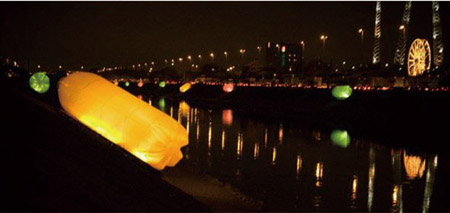
Researcher: Gabriela Ribeir Region: Latin America
The Tietê River has 1100 km of extension long and it bathes 62 municipal regions of São Paulo. The River has a great importance in the history of the country, which served as a route for pioneers called “Bandeirantes” in the eighteenth century. These adventurers, who expanded the Brazilian territory, used the Tietê to reach the interior of the state of São Paulo. During the journey, the pioneers “Bandeirantes” founded several cities. It was because of the Tietê River that the city of São Paulo was born.
In the following years, it has been widely used for navigation and even to practice water sports, mainly in the metropolitan region of São Paulo. It was from the 50’s that this situation has changed. With disordered population and industrial growth of the city of São Paulo, the river began to receive domestic and industrial sewage in the stretch of the city, leaving it polluted and contaminated.
The artist Eduardo Srur makes the city and the urban public spaces as his own gallery. An unsuspecting pedestrian might not even know who he is, but it certainly has been impacted by some of their interventions in the metropolis, which are always in places very accessible and very unusual.
And it was through the intervention of the artist that one morning in March 2008, the river Tietê dawned with an unusual scene: 20 giant color- ful bottles with PET (plastic soda bottles) format, "decorating" the river flow.
Paulistanos (São Paulo citizens) and frequent visitors of the city were used to see and feel the smell of the polluted river, and in the middle of this pollution is always possible to see many plastic bottles. And as an usual routine, for those who live with this scenario, everything becomes unno- ticed. With this intervention the artist piqued the gaze of the people so that they pay attention to the pollution that always pervades the city, after all, the Tietê river runs through a very extensive area of São Paulo. However if you realize that the artist work visually reactivated the river flow.
The 20 huge bottles made of vinyl, inflated and fixed in floating platform remained for two months on the river concrete, and it was seen by over 60 million people. And also featured an educational project that took 3000 children and teachers from public schools to visit the river by boat and see the work, an unique opportunity to embark on the Tietê river, which by their current conditions, are restricted accesses to the area within the riverbanks.
At the end of exposure, the plastic material of the inflatable bottle was reused for a purpose very consistent with the proposed work. Upon the Mr. Srur request, artist and Brazilian designer Jum Nakao designed and produced backpacks made with the pads of the work to be donated to the schools that made the ride.
Therefore, it is concluded that message of the work goes beyond the environmental issue: it proposes recycling the look, bringing citizens to rethink their city. The PETS project beyond the exposed Tietê River, it was also on display at Guarapiranga and in the city of Bragança Paulista, São Paulo. |